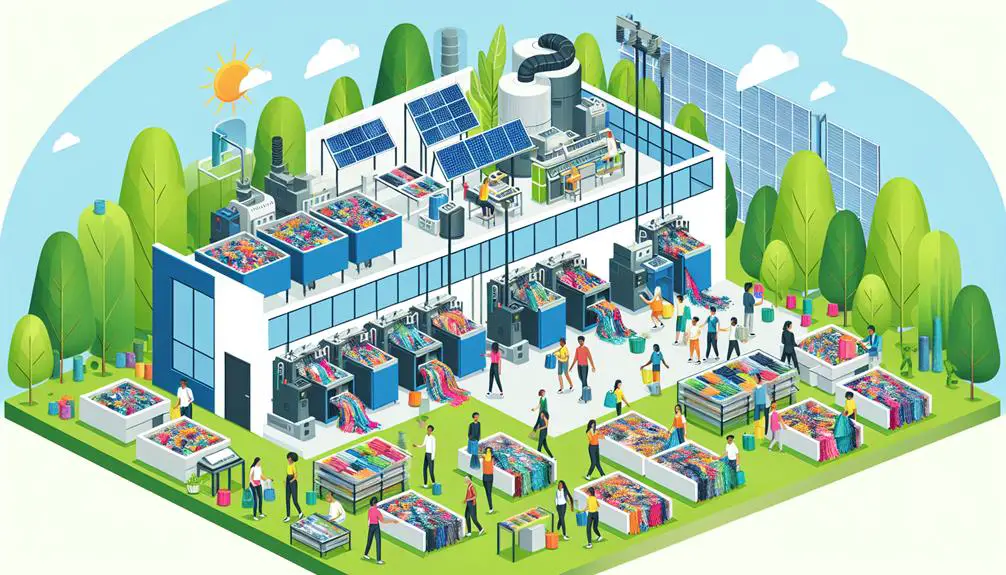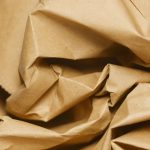Imagine textile waste as a growing mountain that threatens to overshadow our environment. You have the power to help dismantle this mountain through innovative approaches. From advanced recycling technologies and creative upcycling methods to adopting circular economy models, the solutions are multifaceted. By supporting sustainable design and zero-waste manufacturing, you can play a pivotal role in this transformation. But how do these initiatives really work, and what impact can they have on the future of fashion? Let's explore the practical steps and real-world examples that bring these innovations to life.
Table of Contents
Key Takeaways
- Textile incineration converts non-recyclable textiles into renewable energy, reducing landfill waste.
- Fabric composting decomposes biodegradable textiles into nutrient-rich compost, aiding waste reduction.
- DIY upcycling workshops transform old textiles into new products, promoting sustainability and creativity.
- Pattern Optimization Software minimizes fabric offcuts, enhancing efficient fabric utilization.
- Clothing swaps and community projects encourage reuse, reducing the demand for new textiles.
Recycling Technologies
Cutting-edge recycling technologies are transforming how we handle textile waste. You can now leverage advanced methods like textile incineration and fabric composting to address the growing concern of textile waste. Gone are the days of simply discarding old clothes; today, you can engage in more sustainable practices that contribute to a circular economy.
Textile incineration, while controversial, offers a way to manage non-recyclable textiles efficiently. By converting waste into energy, it reduces landfill usage and provides a renewable energy source. You must be aware, however, of the potential environmental impact and make sure that incineration facilities adhere to strict emission standards.
On the other hand, fabric composting presents an eco-friendly option for natural fibers. This method allows you to decompose biodegradable textiles into nutrient-rich compost, which can then be used to enrich soil. By understanding the specific requirements for fabric composting—such as avoiding synthetic blends and maintaining proper composting conditions—you can effectively reduce textile waste while contributing to soil health.
Upcycling Methods
Upcycling methods offer creative ways to transform old textiles into new, valuable products, reducing waste and fostering sustainability. By engaging in DIY upcycling workshops, you can master techniques that breathe new life into discarded fabrics. These workshops not only promote sustainable textile innovations but also empower you to contribute to eco-friendly fashion trends.
Imagine turning a worn-out pair of jeans into a chic tote bag or converting outdated curtains into fashionable skirts. Creative repurposing like this allows you to utilize your old textiles in imaginative ways, reducing the need for new materials and cutting down on textile waste. You'll find that each upcycled item carries a unique story, adding intrinsic value and personal significance.
Sustainable textile innovations are at the forefront of this movement, offering new materials and methods that make upcycling even more efficient and impactful. From biodegradable dyes to advanced stitching techniques, these innovations provide you with the tools to create high-quality, eco-conscious fashion.
Circular Economy Models
Embracing circular economy models can drastically minimize textile waste by keeping materials in use for as long as possible. By adopting these models, you're not just reducing waste but also contributing to a more sustainable and efficient fashion industry.
Here's how you can leverage circular economy principles:
- Textile Repurposing: Transform old garments into new items. This process not only achieves waste reduction but also gives new life to materials that would otherwise end up in landfills.
- Circular Fashion: Engage in practices that guarantee garments are designed, produced, and consumed in a way that makes them easy to recycle or repurpose. Staying updated with sustainability trends helps you make informed choices.
- Extended Product Life: Encourage practices like repair, resale, and rental. By extending the life of textiles, you'll reduce the demand for new raw materials and lower the overall environmental footprint.
Sustainable Design
When you think about sustainable design, consider upcycled fashion trends that breathe new life into old garments.
Zero-waste pattern cutting can revolutionize how clothes are made by reducing fabric scraps.
Additionally, choosing eco-friendly fabrics helps minimize the environmental impact of textile production.
Upcycled Fashion Trends
In the domain of sustainable design, upcycled fashion trends are transforming old garments into stylish, eco-friendly statements. By harnessing the power of vintage revival and creative repurposing, you can turn forgotten pieces into modern masterpieces. This movement is more than a trend; it's a commitment to fashion sustainability and artistic transformations.
Here are three compelling reasons to embrace upcycled fashion:
- Vintage Revival: Breathing new life into old clothes allows you to enjoy unique, one-of-a-kind pieces that stand out from mass-produced fashion. It's a nod to history while making a bold statement about the future.
- Creative Repurposing: Upcycling encourages you to think outside the box. Transform a worn-out dress into a chic top, or convert outdated jeans into a trendy skirt. The possibilities are endless, limited only by your imagination.
- Artistic Transformations: By incorporating artistic elements such as embroidery, patchwork, or dyeing, you can elevate simple garments into wearable art. This not only supports fashion sustainability but also provides a personalized touch that reflects your unique style.
Zero-Waste Pattern Cutting
Zero-waste pattern cutting revolutionizes sustainable fashion by eliminating fabric waste during the design process. By employing innovative techniques, you can create garments that maximize fabric usage, guaranteeing that every inch serves a purpose. This approach not only contributes to significant waste reduction but also pushes the boundaries of creativity and efficiency in design.
To master zero-waste pattern cutting, consider these key steps:
| Step | Description | Benefit |
|---|---|---|
| Design Planning | Sketch patterns that interlock or use all the fabric | Maximum fabric efficiency |
| Pattern Layout | Arrange patterns to fit within the dimensions of fabric | Zero off-cuts |
| Iteration | Continuously refine patterns based on fabric constraints | Enhanced design innovation |
You'll start by sketching patterns that interlock like puzzle pieces. This method guarantees that no fabric is left unused. Next, carefully lay out these patterns on your fabric, making sure they fit perfectly within the fabric's dimensions. The final step involves iterating and refining your patterns, constantly challenging yourself to improve and innovate.
Eco-Friendly Fabric Choices
Choosing eco-friendly fabrics is essential for sustainable design, as it minimizes environmental impact and promotes ethical production practices. By selecting the right materials, you can greatly contribute to a more sustainable fashion industry. Here are three compelling options to contemplate:
- Natural fibers: Opt for materials like organic cotton, linen, and hemp. These fibers not only reduce pesticide use but also enhance biodegradability, ensuring less waste in landfills.
- Vegan textiles: Choose innovative materials like Piñatex (pineapple leather) and Tencel (lyocell). These alternatives reduce the environmental impact associated with animal-derived products.
- Recycled fabrics: Embrace textiles made from post-consumer waste, such as recycled polyester. This approach helps in diverting waste from landfills and reducing the need for virgin resources.
Natural fibers offer superior biodegradability, making them a top choice for environmentally conscious designers.
By integrating vegan textiles, you can address the environmental impact of traditional leather and silk, promoting cruelty-free alternatives.
Recycled fabrics further enhance sustainability by minimizing waste and resource consumption.
Each of these choices empowers you to create innovative, eco-friendly designs that not only look good but also do good for the planet.
Zero-Waste Manufacturing
You can greatly reduce textile waste through zero-waste manufacturing by efficiently using fabric and adopting circular production models.
This approach guarantees every scrap of material serves a purpose, reducing the need for new resources.
Embracing these methods not only minimizes waste but also promotes a sustainable and eco-friendly production cycle.
Efficient Fabric Utilization
Manufacturers are revolutionizing the textile industry by implementing cutting-edge techniques to guarantee every scrap of fabric is utilized effectively. By focusing on fabric efficiency, they're able to reduce waste significantly, making sure that no material goes unused.
You can harness these advancements to enhance your own textile processes and contribute to a more sustainable future.
Consider these innovative approaches to effective fabric utilization:
- Pattern Optimization Software: Advanced software can meticulously plan the layout of patterns on fabric, reducing offcuts and maximizing the use of every inch. This not only boosts fabric efficiency but also drives down costs.
- Modular Design Techniques: By creating garments that can be easily disassembled and reassembled, you minimize waste and increase the lifespan of each piece. Modular designs allow for parts to be replaced or updated without discarding the entire item.
- Laser Cutting Technology: Utilizing precision laser cutting ensures minimal fabric waste. This technology allows for intricate designs and exact cuts, leaving less room for error and excess material.
Circular Production Models
Building on the principles of efficient fabric utilization, adopting circular production models guarantees that every stage of the manufacturing process contributes to a zero-waste system. You can achieve significant waste reduction by designing garments with end-of-life in mind. This means selecting materials that are easy to recycle and creating designs that minimize off-cuts.
In a circular system, material recovery becomes essential. Instead of discarding scraps, you can reintroduce them into the production cycle. For instance, fabric remnants can be shredded and spun into new yarn, or smaller pieces can be used for patchwork projects. By doing so, you're not only reducing waste but also cutting down on the need for virgin materials.
Additionally, closed-loop systems, where garments are designed to be disassembled, can greatly enhance material recovery. By ensuring that every component of a product can be reused or recycled, you create a sustainable loop that keeps materials in circulation. This approach isn't just good for the environment; it also offers economic benefits by reducing raw material costs and fostering innovation.
In essence, circular production models are your blueprint for a sustainable, zero-waste future in textile manufacturing. Embrace them to lead the way in waste reduction and material recovery.
Consumer Initiatives
Through mindful purchasing and participation in recycling programs, consumers play a pivotal role in reducing textile waste. By embracing the power of collective action, you can make a significant impact. Here's how you can contribute effectively:
- Clothing swaps and community projects: Organize or participate in clothing swaps within your community. These events allow you to exchange items you no longer wear for something new-to-you, reducing the demand for new textiles and promoting reuse. Community projects focusing on textile upcycling can also foster creativity and sustainability.
- Sustainable shopping: Opt for brands that prioritize eco-friendly practices. Look for certifications such as GOTS (Global Organic Textile Standard) or Fair Trade, ensuring your purchases support ethical production. By choosing quality over quantity, you're investing in pieces that last longer, reducing waste.
- Conscious consumption: Develop a habit of questioning your clothing needs. Before buying, ask yourself if you genuinely need the item or if it can be borrowed, rented, or thrifted. This mindset minimizes impulsive purchases and curtails the volume of discarded textiles.
Frequently Asked Questions
How Can Individuals Reduce Textile Waste in Their Daily Lives?
You can master reducing textile waste by repairing clothes, repurposing old fabrics, recycling unwanted garments, donating wearable items, and upcycling materials into new creations. Each action helps minimize waste and promotes sustainability.
What Role Do Governments Play in Minimizing Textile Waste?
Governments are the heroes of textile waste reduction! They enact stringent regulations and policy initiatives, ensuring sustainable practices. You can see their influence in waste management systems and incentives for recycling, driving massive change.
Are There Any Financial Incentives for Companies to Adopt Sustainable Practices?
Yes, there are financial incentives for companies to adopt sustainable practices. By embracing corporate responsibility, you can benefit from tax breaks, subsidies, and increased consumer trust, ultimately enhancing your company's profitability and long-term sustainability.
What Are the Environmental Impacts of Textile Waste on Oceans?
You'll notice textile waste's environmental impacts are severe, causing marine pollution and microplastic contamination. These pollutants damage marine life, disrupt ecosystems, and ultimately affect human health through the food chain. Master these issues for impactful solutions.
How Can Education and Awareness Programs Help in Reducing Textile Waste?
You can reduce textile waste by participating in school programs and community engagement initiatives. These programs educate you on sustainable practices, fostering a mastery of responsible consumption and waste reduction techniques.
- Can You Steam Clean a Leather Sofa? - July 9, 2025
- Are Leather Sofas in Style? A Look at Current Trends - July 9, 2025
- Mixing Leather and Fabric Furniture: A Style Guide - July 9, 2025





